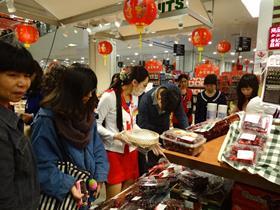
China’s appetite for cherries in the run-up to the Lunar New Year continues to astonish, with sales volumes of Chilean fruit reportedly “flying” as the nation gears up for the start of the festive holiday next Friday.
At Jiangnan wholesale market in Guangzhou, the key distribution and trading hub for buyers from all over China, Chilean cherries are moving at an incredible rate, according to Rod Hill, import manager of Golden Wing Mau.
“The market is fantastic,” he said, speaking from Jiangnan on Friday morning. “Around 3m cartons [of cherries] have arrived this week, and they’re just disappearing.
“Two days ago, the market moved 110 container loads (or half a million cartons), and they all sold without any problems. A big vessel, the Hanjin Chicago, just arrived loaded with Chilean cherries – and half the fruit has already sold.”
While Jiangnan remains the major trading hub, Kurt Huang of Shanghai Huizhan Fruit and Vegetable Wholesale Market confirmed that direct cherry shipments into Shanghai were also being snapped up. “The market is going crazy for Chilean cherries. Everything is selling well, but cherries are the standout,” said Huang.
Hamburg Süd’s Monte Pascoal vessel docked in Shanghai on Thursday night carrying around 130 container loads of Chilean cherries. “We’re trucking them to Huizhan market now and by 5pm this evening we expect around 40-50 container loads to be lined up for sale.”
While port congestion in Shanghai had delayed some vessels, he said it had not caused significant disruption to cherry arrivals.
Plain sailing
Movement of Chilean cherries has been strained by logistical problems in China over recent years, most notably in 2012, when an early Chinese New Year combined with an onslaught of late arrivals, led to a logjam at Jiangnan market. Hill said there are no such issues this year.
“All the distribution problems seem to have been sorted out and they’ve opened a completely new part of Jiangnan which has made things much smoother and more organised,” he said. “Containers are getting in and moving fast.”
Indeed, with logistical hurdles removed, the sheer consumption power of the Chinese market has come to the fore, he notes.
“Not only is the fruit that’s arrived moving well, but sales continues to strengthen – it’s incredible that the market can absorb this kind of volume in such a short period of time, and the Chilean people with me here are astounded by what they’re seeing.”
Overall volumes of Chilean cherry imports to China this season are likely to finish at similar levels to 2012/13, at around 8.2m cartons, Hill estimated.
“The key difference this year though is that the market was about a million cartons behind because we hardly got any early fruit due to the frosts in Chile,” he said. “Between the first week of January and Chinese New Year, we’ve had 4.5m-5m cartons of cherries arriving – and it’s all being moving and getting asborbed. All the retailers are promoting them and the fruit is moving very quickly.”
Import shortage
The stellar performance of cherries also comes against the backdrop of a “general shortage of imported fruit” in China for Chinese New Year this year, according to Hill.
“There don’t seem to be a lot of US grapes, oranges or apples around, volumes of Peruvian Red Globes are very limited and there’s a shortage of the key tropical fruits, like durian and longan,” he said. “Durian has been selling for RMB500 per box.”
Indeed, Hill said the shortage has created headaches for Chinese retailers looking for fruit to promote for the festivities, putting cherries in pole position.
“When you go into retail stores, there’s not much on offer, and there’s a notable shortage of tropical fruits, so everything’s expensive,” he said. “Cherries have become the focal point of promotions in many stores, which has not always been the case.”
Huang said tropical fruits were selling well in Shanghai, and that the price of longan had shot up by 40 per cent.
Hill believes the shortage of Peruvian grapes could be related to a later-running season there, and a higher percentage of darker-coloured Red Globe in the northern growing regions, which is not suited to the Chinese market. “I suspect many shippers decided not to send fruit here,” he said.
South African grape volumes arriving for Chinese New Year are also down significantly on last year, he added, a shortfall he attributes to climatic setbacks in the growing areas.
“Any grapes are going very quickly because supplies are so short,” said Hill.
Another factor contributing to strong movement of Chilean cherries and other imported fruit in Guangzhou has been recent fine weather in southern China, he observed.
“The weather in southern China has been fantastic – usually we expect cold, dank days at this time of year, but it’s been very fine, which is only helping sales movement.”
The Chinese New Year holiday runs from 31 January through to 6 February, and with only a week of sales left, Hill is hopeful the good run will continue, and that the remainder of shipments will be “absorbed at strong prices”.



